
 |
Exam-Style Questions.Problems adapted from questions set for previous Mathematics exams. |
1. | IB Studies |
A function is given as \(f(x)=3x^2-6x+4+\frac3x,-2\le x \le 4, x\ne 0\).
(a) Find the derivative of the function. (b) Find the coordinates of the local minimum point of \(f(x)\) in the given domain using your calculator.2. | IB Studies |
Consider the graph of the function \(f(x)=7-3x^2-x^3\)
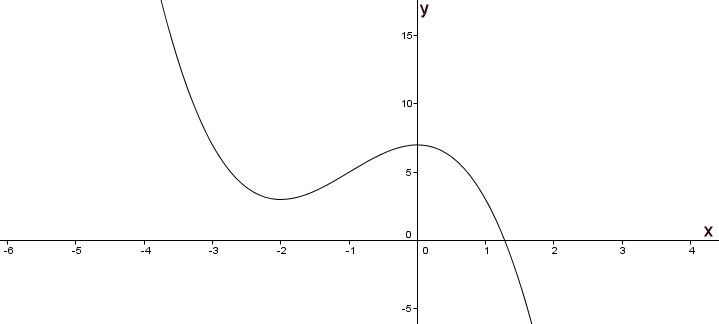
(a) Label the local maximum as A on the graph.
(b) Label the local minimum as B on the graph.
(c) Write down the interval where \(f(x)>5\).
(d) Draw the tangent to the curve at \(x=-3\) on the graph.
(e) Write down the equation of the tangent at \(x=-3\).
3. | IB Standard |
Consider the graph of \(f(x)=a\sin(b(x+c))+12\), for \(0\le x\le 24\).
The graph has a maximum at (8, 22) and the next local minimum at (18, 2).
(a) Find the value of \(a\).
(b) Find the value of \(b\).
(c) Find the value of \(c\).
(d) Solve \(f(x)=5\).
4. | A-Level |
(a) Find \( \frac{dy}{dx} \) when:
$$ y= (7-5x^2)^{ \frac12 } $$(b) Find the following integral:
$$ \int (1 - cos3x) dx$$5. | IB Analysis and Approaches |
Consider the function \(f\) defined by \(f(x)= \ln{(x^2 - 9)}\) for \(x > 3\).
The following diagram shows part of the graph of \(f\) which crosses the x-axis at point \(A\) with coordinates \((a,0)\).
The line \(L\) is the tangent to the graph of \(f\) at the point \(B\) with coordinates \((b,c)\). The gradient of \(L\) is \( \frac14\)
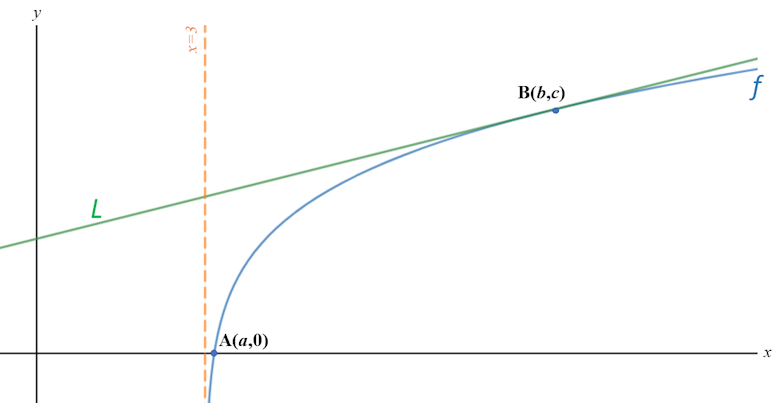
(a) Find the exact value of \(a\).
(b) Find the value of \(b\).
6. | IB Standard |
The diagram shows part of the graph of \(y=a\sin{(bx)}+c\) with a minimum at \((-2.5,-2)\) and a maximum at \((2.5,4)\).
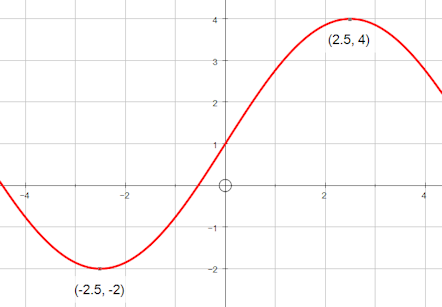
(a) Find \(a\).
(b) Find \(b\).
(c) Find \(c\).
7. | IB Analysis and Approaches |
The function \(f\) is defined by \(f(x) = 8 - 5 \sin{x} \), for \( x \ge 0 \).
The diagram shows part of the graph of \(y = f (x) \).
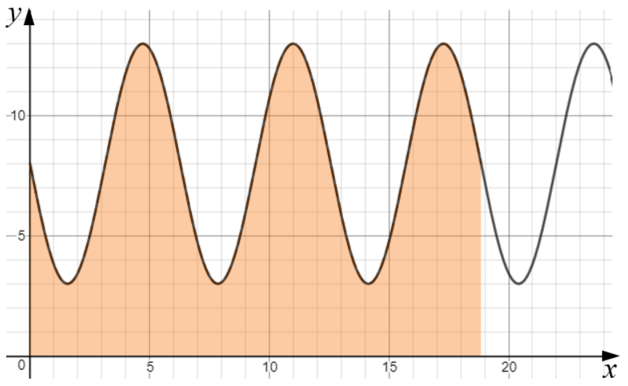
The shaded region is enclosed by the graph of \(y=f(x)\) and the x-axis for the first three periods of the function.
(a) Find the exact value of the x-coordinate of the right side of the shaded region.
(b) Show that the area of the shaded region is \( 48 \pi \).
A hemisphere has a total surface area in square centimetres equal to the shaded area in the previous diagram.
(c) Find the radius of the hemisphere.
8. | IB Analysis and Approaches |
A particle moves in a straight line such that its velocity, \(v\) ms-1, at time \(t\) seconds is given by:
$$ v(t)=10e^{-\frac{t}{7}} \sin\left(\frac{t}{2}\right) $$for \( 0 \le t \le 4 \pi\). The graph of \(v\) is shown in the following diagram.
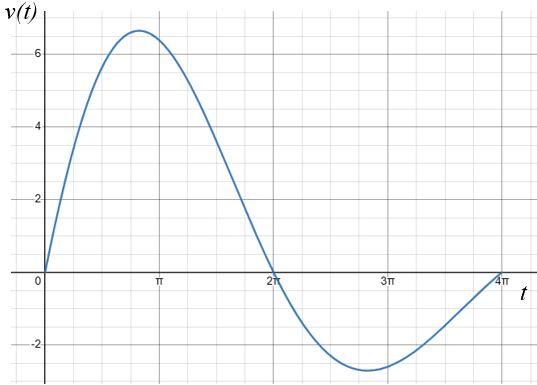
Let \(t_1 \) be the first time when the particle's acceleration is zero.
(a) Find the value of \(t_1\).
(b) Find the distance travelled by the particle between \(t = t_1 \), and t = \(4 \pi \).9. | IB Analysis and Approaches |
Consider the cubic function \(f(x)=\frac{1}{6}x^3-2x^2+6x-2\)
(a) Find \(f'(x)\)
The graph of \(f\) has horizontal tangents at the points where \(x = a\) and \(x = b\) where \( a < b \).
(b) Find the value of \(a\) and the value of \(b\)
(c) Sketch the graph of \(y = f'(x)\).
(d) Hence explain why the graph of \(f\) has a local maximum point at \(x = a\).
(e) Find \(f''(b) \).
(f) Hence, use your answer to part (e) to show that the graph of \(f\) has a local minimum point at \(x = b\).
(g) Find the coordinates of the point where the normal to the graph of \(f\) at \(x = a\) and the tangent to the graph of \(f\) at \(x = b\) intersect.
10. | IB Studies |
Consider the function \(f(x)=x^3-9x+2\).
(a) Sketch the graph of \(y=f(x)\) for \(-4\le x\le 4\) and \(-14\le y\le 14\) showing clearly the axes intercepts and local maximum and minimum points. Use a scale of 2 cm to represent 1 unit on the x-axis, and a scale of 1 cm to represent 2 units on the y-axis.
(b) Find the value of \(f(-1)\).
(c) Write down the coordinates of the y-intercept of the graph of \(f(x)\).
(d) Find \(f'(x)\).
(e) Find \(f'(-1)\)
(f) Explain what \(f'(-1)\) represents.
(g) Find the equation of the tangent to the graph of \(f(x)\) at the point where x is –1.
R and S are points on the curve such that the tangents to the curve at these points are horizontal. The x-coordinate of R is \(a\) , and the x-coordinate of S is \(b\) , \(b \gt a\).
(h) Write down the value of \(a\) ;
(i) Write down the value of \(b\).
(j) Describe the behaviour of \(f(x)\) for \(a \lt x \lt b\).
11. | IB Analysis and Approaches |
The displacement, in millimetres, of a particle from an origin, O, at time t seconds, is given by \(s(t) = t^3 cos t + 5t sin t\) where \( 0 \le t \le 5 \) .
(a) Find the maximum distance of the particle from O.
(b) Find the acceleration of the particle at the instant it first changes direction.
12. | IB Standard |
The function \(f\) is defined as follows:
$$f(x)=\frac{122}{1+60e^{-0.3x}}$$(a) Calculate \(f(0)\).
(b) Find a value of \(x\) for which \(f(x)=85\)
(c) Find the range of \(f\).
(d) Show that:
$$f'(x)=\frac{2196e^{-0.3x}}{(1+60e^{-0.3x})^2}$$(e) Find the maximum rate of change of \(f\).
13. | IB Analysis and Approaches |
Consider the functions
$$f(x) = m-x^2 - 2xn - n^2$$ $$g(x) = \frac{e^x}{e^2} + \frac{m}{2}$$where \(m, n \in \mathbb R\)
(a) Find \( f'(x)\).
(b) Find \( g'(x)\).
The graphs of \(f\) and \(g\) have a common, non-vertical tangent at \(x=3\).
(c) Find expressions for \(m\) and \(n\) in terms of \(e\).
14. | IB Standard |
A particle P moves along a straight line. The velocity \(v\) in metres per second of P after \(t\) seconds is given by \(v(t) = 3\sin{t} - 8t^{\cos{t}}, 0 \le t \le 7\).
(a) Find the initial velocity of P.
(b) Find the maximum speed of P.
(c) Write down the number of times that the acceleration of P is 0 ms-2.
(d) Find the acceleration of P at a time of 5 seconds.
(e) Find the total distance travelled by P.
15. | IB Analysis and Approaches |
Consider a function \(f\), such that \(f(x)=7.2\sin(\frac{\pi}{6}x + 2) + b\) where \( 0\le x \le 12\)
(a) Find the period of \(f\).
The function \(f\) has a local maximum at the point (11.18,10.3) , and a local minimum at (5.18.-4.1).
(b) Find the value of b.
(c) Hence, find the value of \(f(7)\).
A second function \(g\) is given by \(g(x)=a\sin(\frac{2\pi}{7}(x -4)) + c\) where \(0 \le x \le 10\)
The function \(g\) passes through the points (2.25,-3) and (5.75,7).
(d) Find the value of \(a\) and the value of \(c\).
(e) Find the value of x for which the functions have the greatest difference.
16. | IB Analysis and Approaches |
Consider the function \(f\) defined by \(f(x) = 25e^{x-5}\) for \(x \in \mathbb{R}^+\).
(a) Find the coordinates of the points where the graph of \(f\) intersects the line \(y=x\).
The line \(L\) has a gradient of \(-1\) and is a normal to the graph of \(f\) at the point \(R\).
(b) Find the exact coordinates of \(R\).
(c) Show that the equation of the line \(L\) is \(y=-x+6- \ln{25}\).
(d) Find the area of the region enclosed by the graph of \(f\) and its inverse.
17. | IB Analysis and Approaches |
The height of water in metres above Chart Datum* in the Port of Bristol on a day in January is modelled by the function:
$$H(x) = a \sin(b(x-c)) +d$$where \(x\) is the number of hours after midnight GMT, and \(a,b,c, \text{ and } d \) are constants greater than zero.
The following graph shows the height of the water for 19 hours starting at midnight.
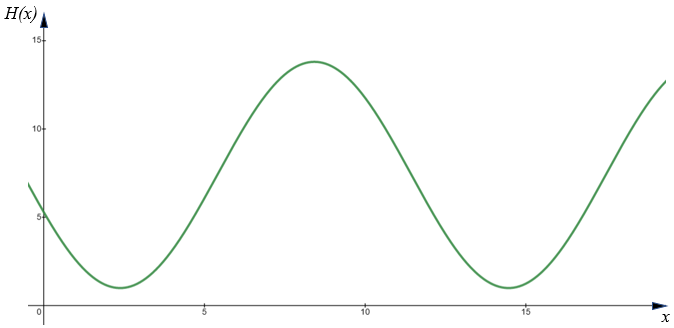
The first low tide occurs at 02:23 and next low tide occurs at 14:28.
Throughout the day the height of the water fluctuates between 1m and 13.8m.
(a) Show that \(a = 6.4\).
(b) Find the value of \(b\) to two decimal places.
(c) Find the value of \(d\).
(d) Find the smallest possible value of \(c\) to one decimal place.
(e) Using the values of \(a,b,c, \text{ and } d \) found above, find the height of the water at 10:00.
(f) Determine the number of hours, during this January day, for which the tide is higher than 10 metres above Chart Datum.
* Chart Datum is a reference datum or level from which heights and depths on a nautical chart are measured. Chart Datum is determined by the lowest astronomical tide, which is the level of the sea at its lowest possible level. It is also the reference level used to measure the depth of water in a harbour or other body of water.
18. | IB Analysis and Approaches |
Let \(f(x) = \frac{ln3x}{kx} \) where \( x \gt 0\) and \( k \in \mathbf Q^+ \).
(a) Find an expression for the first derivative \(f'(x) \).
The graph of \(f\) has exactly one maximum point at P.
(b) Find the x-coordinate of P.
The graph of \(f\) has exactly one point of inflection at Q.
(c) Find the x-coordinate of Q.
(d) The region enclosed by the graph of \(f\), the x-axis, and the vertical lines through P and Q has an area of one square unit, find the value of \(k\).
If you would like space on the right of the question to write out the solution try this Thinning Feature. It will collapse the text into the left half of your screen but large diagrams will remain unchanged.
The exam-style questions appearing on this site are based on those set in previous examinations (or sample assessment papers for future examinations) by the major examination boards. The wording, diagrams and figures used in these questions have been changed from the originals so that students can have fresh, relevant problem solving practice even if they have previously worked through the related exam paper.
The solutions to the questions on this website are only available to those who have a Transum Subscription.
Exam-Style Questions Main Page
To search the entire Transum website use the search box in the grey area below.
Do you have any comments about these exam-style questions? It is always useful to receive feedback and helps make this free resource even more useful for those learning Mathematics anywhere in the world. Click here to enter your comments.